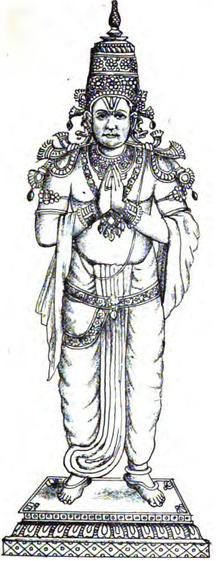Religion Hinduism Honors Alvar saint | Philosophy Vaishnava Bhakti Books Mukundamala | |
 | ||
Literary works Mukundamala, Perumal Tirumozhi (Tamil language) | ||
Song on kulashekhara alwar
Kulashekhara Alwar (also known as Kulashekhara Varman, Kulashekhara Alvar or Kulashekhara Nayanar) was one of the Alwars. According to traditional scriptures, he was born in the 27th year after the beginning of the Kali Era (3102 BC), thus 3075 BC.
Contents
- Song on kulashekhara alwar
- Early life
- As a king
- As saint
- Works and hymns
- Mannarkoyil Temple
- Travancore royal family
- References
Kulasekhara is one of the twelve Tamil alwar saints of South India, who are known for their affiliation to Vaishnava tradition of Hinduism. The verses of the alwars are compiled as Nalayira Divya Prabandham and the 108 temples revered are classified as Divya desam. He is considered the seventh in the line of the twelve alwars. He authored the Sanskrit lyrics Mukundamala and Perumal Tirumozhi, which are compiled as a part of Nalayira Divya Prabandham. He is sometimes identified as Kulasekhara, the author of the Sanskrit works such as Tapatisamvaranam, Subhadradhananjaya and Vichchinnabhiseka. The verses of Kulasekhara and other azhwars are recited as a part of daily prayers and during festive occasions in most Vishnu temples in South India.
Early life
Born in Periyar, Kerala, he was son of Drdhavrata. As per scriptural evidence, Kuleshekara Alwar incarnated on this earth in the 27th year after the beginning of the Kali Era (3102 BC), thus 3075 BC.
As a king
Kulashekhara is believed to have been a king from the Kerala region and he is regarded by some to have ruled Kolli (modern-day Uraiyur), Koodal (modern day Madurai) and Kongu. The given date of his period is said to be 800–820 AD, as a king of the later Chera Dynasty. It is further suggested that he could not have flourished after the end of the 9th century, and a king of Pallava dynasty (2nd century – 9th century) further claims to have defeated the Chera.
As saint
He is revered as the seventh of the twelve alvars, saints whose works contributed to the philosophical and theological ideas of Vaishnavism. He is also one of the celebrated Vaishnavite alvar poet-saints of the Bhakti movement in South India. The Bhakti movement consolidated the Vedic religion in the region by introducing it to common people.
Works and hymns
He is the author of Mukundamala, a devotional lyric in Sanskrit. He contributed to one of the works in the Divya Prabhandham, namely Perumal Thirumozhi. These works consists of 105 poems out of the 4,000 hymns written by the Alvar poet-saints. His poems are devotional in nature, being dedicated to the most prominent Avatars of Vishnu (Rama and Krishna).
A devotee of Rama, he considered the painful experiences of Rama to be his own. He is therefore also known as ‘Perum-al’, meaning "The Great’ – an epithet for the Lord. His devotion was so intense that he worshipped the devotees as forms of Vishnu. In one song, he identifies himself with Devaki, the biological mother of Krishna, from whom Krishna was taken away to Gokul where Nanda and Yasodha, the foster parents, looked after them. Kulasekara expresses Devaki's desolation at being separated from her child and for union with him. This is the same sense of sorrow of separation and yearning for union that pervades the outpourings of all the mystic poets of India.
Mannarkoyil Temple
Kulashekhara Alwar is thought to have died in Tamil Nadu at Mannarkoyil, where there is a temple called Kulasekara Alwar Koyil. The mural inscriptions there informs that the temple was consecrated to his memory by Vasudevan of Mullappalli, Kerala (Malaimandalam).
Sri Srinivasa Perumal Kulasekara Azhwar temple at the birthplace of Kulasekhara Alwar is at Thirukkulasearapuram, within the limits of Thiruvanjikulam, near Kodungallur in Thrissur district, Kerala.
Travancore royal family
The Maharajas of Travancore, custodians of the famous Padmanabhaswamy Temple, are descendants of Kulasekhara Alwar. One of the titles the Maharajas had was Kulasekhara Perumal and the family still possesses his 'Cheramudi' (crown).
